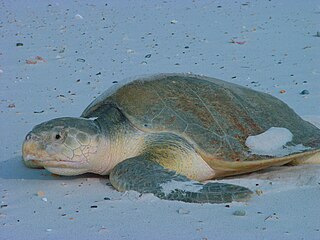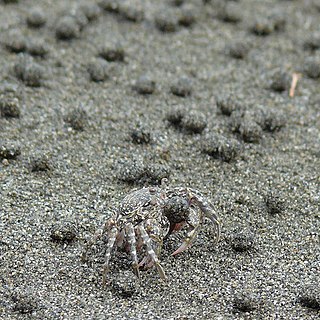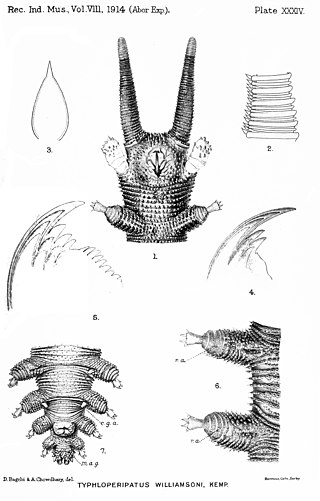
Cheloniidae is a family of typically large marine turtles that are characterised by their common traits such as, having a flat streamlined wide and rounded shell and almost paddle-like flippers for their forelimbs. They are the only sea turtles to have stronger front limbs than back limbs. The six species that make up this family are: the green sea turtle, loggerhead sea turtle, olive ridley sea turtle, hawksbill sea turtle, flatback sea turtle and the Kemp's ridley sea turtle.

Neoceratodus is a genus of lungfish in the family Neoceratodontidae. The extant Australian lungfish is the only surviving member of this genus, but it was formerly much more widespread, being distributed throughout Africa, Australia, and South America. Species were also much more diverse in body plan; for example, the Cretaceous species Neoceratodus africanus was a gigantic species that coexisted with Spinosaurus in what is now the Kem Kem Formation of Morocco. The earliest fossils from this genus are of Neoceratodus potkooroki from the mid Cretaceous (Albian-Cenomanian) Griman Creek Formation of Australia, remains from the Late Jurassic of Uruguay assigned to this genus probably do not belong to the genus.

Kemp's ridley sea turtle, also called the Atlantic ridley sea turtle, is the rarest species of sea turtle and is the world's most endangered species of sea turtle. It is one of two living species in the genus Lepidochelys.

Ridley sea turtles are a genus (Lepidochelys) of sea turtle comprising two species: Kemp's ridley sea turtle and the olive ridley sea turtle.

Sand bubbler crabs are crabs of the genera Scopimera and Dotilla in the family Dotillidae. They are small crabs that live on sandy beaches in the tropical Indo-Pacific. They feed by filtering sand through their mouthparts, leaving behind balls of sand that are disintegrated by the incoming high tide.

Paratya is a genus of freshwater shrimp of the family Atyidae, found in various islands in the Pacific Ocean. The split between the North Pacific clade (Japan) and the South Pacific clade has been estimated to have occurred 19 to 12.5 million years ago.

Palaemonidae is a family of shrimp in the order Decapoda. Many species are carnivores that eat small invertebrates, and can be found in any aquatic habitat except the deep sea. One significant genus is Macrobrachium, which contains commercially fished species. Others inhabit coral reefs, where they associate with certain invertebrates, such as sponges, cnidarians, mollusks, and echinoderms, as cleaner shrimps, parasites, or commensals. They generally feed on detritus, though some are carnivores and hunt tiny animals.

Siebenrockiella is a small genus of black marsh turtles. It used to be monotypic but now has two species with the addition of the Philippine forest turtle. The genus was originally erected in 1869 by John Edward Gray under the name Bellia, commemorating Thomas Bell, but this name is a junior homonym of Bellia Milne-Edwards, 1848, a crustacean genus. The replacement name, Siebenrockiella, was published in 1929 by Wassili Adolfovitch Lindholm, and commemorates Friedrich Siebenrock.

Ambuchanania leucobryoides is the only species in the monotypic genus Ambuchanania. It is a Sphagnum-like moss endemic to Tasmania. Originally described as a species of Sphagnum, it is now a separate genus named after the original collector Alex M. Buchanan, (b.1944) an Australian botanist from the Tasmanian Herbarium in Hobart,. A. leucobryoides differs from the family Sphagnaceae in having elongate antheridia. It is entirely restricted to south-west Tasmania's Wilderness World Heritage Area where it occurs on white Precambrian quartzitic sand deposited by alluvial flows, and on margins of buttongrass sedge land. Species most commonly found in association with A. leucobryoides include: Leptocarpus tenax, Chordifex hookeri, and Actinotus suffocatus. Currently, A. leucobryoides is listed as rare under the Tasmanian Threatened Species Protection Act 1995.

Regisaurus is an extinct genus of small carnivorous therocephalian. It is known from a single described species, the type species Regisaurus jacobi, from the Early Triassic Lystrosaurus Assemblage Zone of South Africa, although at least one undescribed species is also known.

Typhloperipatus is a genus of velvet worm in the family Peripatidae, containing the sole species Typhloperipatus williamsoni. It is the only species in the phylum found in South Asia. The species was discovered in northeastern India in 1911.
Batella is a genus of snapping shrimp comprising three species:
Leptocarpus may refer to:

Leptocarpus is a genus of dioeceous rush-like perennial plants described as a genus in 1810.

Periclimenes, commonly known as glass shrimp or cleaner shrimp, is a commensal and often symbiotic genus of semi-transparent shrimp within the family Palaemonidae. Species of this large genus feature a wide variety of coloration and patterns, widespread distribution throughout much of the world's tropical oceans, and are often sought out for aquarium trade.

Chaetanthus aristatus is a species of rush. It is found in Western Australia.
Leptocarpus laxus is a rush species of the genus Leptocarpus in the family Restionaceae. It is endemic to the south-west of Western Australia.

Leptocarpus tenax is a species of plant in the family Restionaceae. It is perennial, dioecious herb found in many moist parts of eastern and southern Australia and often seen growing from 50 to 130 cm tall, with stems 1 to 2 mm in diameter. The specific epithet tenax is derived from Latin, meaning "holding fast".

Leptocarpus denmarkicus is a species of plant in the Restionaceae (rush) family, endemic to Western Australia.














